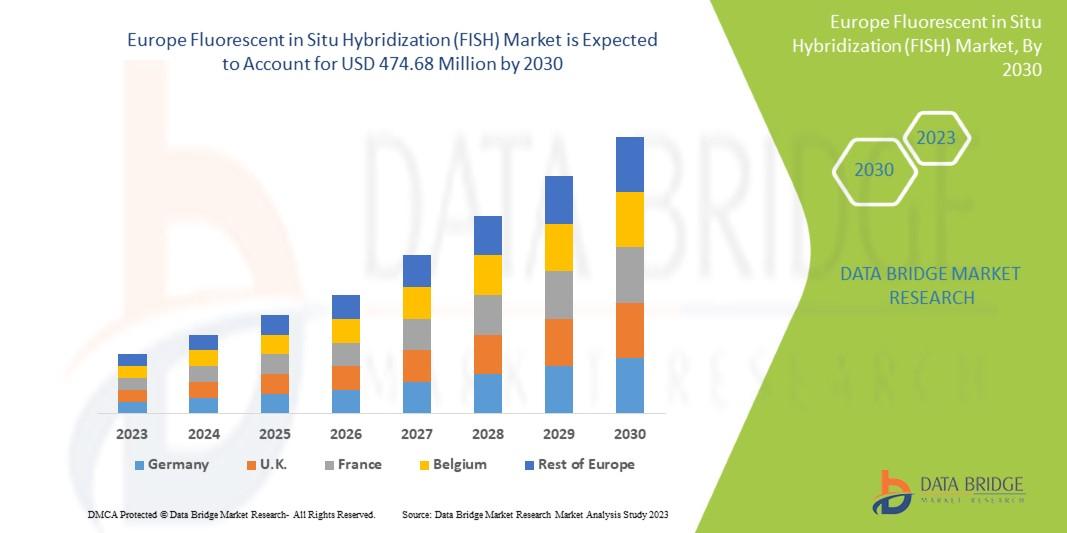
Introduction to FISH Technology
Fluorescent in Situ Hybridization (FISH) is a cytogenetic technique used to detect and localize specific DNA or RNA sequences on chromosomes using fluorescent probes. This method offers high specificity and spatial resolution, making it invaluable in detecting genetic abnormalities, chromosomal rearrangements, and gene amplifications.
In Europe, FISH is widely adopted in oncology diagnostics, prenatal screening, genetic disease research, and pharmaceutical development. As the healthcare ecosystem moves toward precision and personalized medicine, FISH is emerging as a cornerstone diagnostic tool.
Market Overview
The Europe FISH market is estimated at USD 552 million in 2024 and is projected to grow to USD 920 million by 2030, at a CAGR of 8.9%. The growth is driven by the rising burden of cancer and genetic disorders, along with increased demand for advanced molecular diagnostics.
Countries like Germany, the UK, and France are leading in adoption due to their strong research ecosystems, while Eastern Europe is catching up through government investments and healthcare modernization.
Key Market Drivers
1. Rising Cancer and Genetic Disorder Rates
With Europe reporting high incidences of breast, lung, colon, and hematologic cancers, FISH plays a critical role in tumor profiling and treatment planning.
2. Advances in Probe and Imaging Technology
Newer multicolor and multiplex probes, combined with digital imaging systems, allow simultaneous detection of multiple targets—enhancing diagnostic yield.
3. Personalized Medicine Expansion
FISH enables identification of gene mutations and chromosomal abnormalities that guide targeted therapy decisions, especially in HER2-positive breast cancer and ALK-positive lung cancer.
4. EU R&D Support
Programs like Horizon Europe and 1+ Million Genomes Initiative fund innovation and adoption of genomic diagnostics across the region.
Market Restraints and Challenges
- High Setup Costs: Instruments and reagents are expensive for small labs.
- Training and Staffing: Skilled cytogeneticists and molecular pathologists are in short supply.
- Awareness Gaps: Smaller hospitals and rural clinics often lack access to FISH diagnostics.
- Emergence of NGS: Next-generation sequencing (NGS) is growing rapidly and sometimes preferred for comprehensive genomic profiling.
Market Segmentation
By Product:
- Instruments: Microscopes, hybridization stations
- Probes: DNA, RNA, centromere, telomere, and disease-specific
- Software: Image analysis and reporting tools
- Accessories: Slides, buffers, hybridization kits
By Type:
- DNA FISH: Most commonly used for chromosomal disorders and cancer diagnostics
- RNA FISH: Used in transcriptomic studies and viral RNA detection
- Q-FISH: Quantitative applications for telomere length and cell cycle analysis
By Application:
- Cancer Diagnosis
- Prenatal Genetic Testing
- Infertility and Reproductive Health
- Drug Development and Clinical Trials
- Academic Research
By End-User:
- Hospitals
- Clinical Diagnostic Laboratories
- Biotech and Pharma Companies
- Contract Research Organizations (CROs)
Technological Trends in FISH
- Automated Systems: Reduce human error and increase throughput
- Multiplexing: One slide, multiple signals—especially valuable in oncology
- AI Integration: Enhances pattern recognition in complex hybridization images
- Portable FISH: For field or point-of-care testing in rare disease centers and rural labs
Country-Level Market Insights
Germany
Europe’s largest FISH market. Strong demand in university hospitals and private cancer clinics.
United Kingdom
Integrating FISH into NHS genomic testing and using it alongside NGS panels in cancer and prenatal care.
France
Focuses on rare disease diagnostics and oncology. Investment in FISH automation and AI tools.
Nordic Countries
Driven by healthcare digitization and public-private biotech partnerships.
Eastern Europe
Growing diagnostics infrastructure in Poland, Czechia, Hungary, supported by EU health funds.
Key Players in the European FISH Market
- Abbott Molecular: Pioneer in HER2/neu FISH testing
- Agilent Technologies: Offers probes and automated platforms
- Bio-Rad Laboratories: Provides cytogenetic testing kits
- Thermo Fisher Scientific: Broad portfolio including DNA/RNA probes
- BioView: Specializes in FISH imaging software
- Oxford Gene Technology (UK) and MetaSystems (Germany): European innovation leaders
FISH in Cancer Diagnosis and Management
FISH is essential for:
- HER2 Gene Amplification in breast cancer (guides trastuzumab therapy)
- ALK and ROS1 Rearrangement in NSCLC
- BCR-ABL Detection in chronic myeloid leukemia (CML)
- Chromosomal Aberration Analysis in lymphoma and sarcoma
Used both as a diagnostic tool and companion diagnostic (CDx) in targeted oncology therapies.
Regulatory and Quality Landscape
- CE-IVD Marking: Required for clinical-grade FISH probes and systems in Europe.
- IVDR Implementation (2022-2025): Stricter validation and post-market monitoring.
- Ethical Regulations: Consent requirements and counseling for genetic diagnostics.
- Laboratory Accreditation: ISO 15189 and ISO 13485 standards for quality assurance.
Future Opportunities and Innovations
- AI Image Analysis: Accelerates diagnostics and reduces subjectivity
- FISH + NGS Hybrid Panels: Combine spatial and sequence data
- Prenatal Testing Expansion: FISH used in amniocentesis and chorionic villus sampling
- Neurogenetics and Autism Research: New applications in brain-related chromosomal mapping
- Tele-FISH Pathology: Remote analysis in collaboration with European centers of excellence
SWOT Analysis
Strengths:
- High specificity and visual clarity
- Widely accepted in clinical oncology
- Works well with FFPE tissue samples
Weaknesses:
- Labor-intensive and time-consuming
- Costly reagents and capital equipment
Opportunities:
- AI and automation adoption
- Integration with omics and digital pathology
- Demand in developing regions of Europe
Threats:
- NGS cannibalization
- Regulatory compliance complexity
- Pricing pressure in public healthcare
Conclusion
The Europe Fluorescent in Situ Hybridization (FISH) market stands at the crossroads of clinical precision and technological innovation. As the demand for targeted diagnostics and personalized treatments grows, FISH continues to deliver critical insights into the genetic landscape of diseases—especially cancer and congenital disorders.
With rising R&D investment, regulatory support, and integration with AI and genomics, FISH is poised to remain a cornerstone diagnostic tool in Europe’s next-generation healthcare ecosystem.
Get More Details : https://www.databridgemarketresearch.com/request-a-sample/?dbmr=europe-fluorescent-in-situ-hybridization-fish-market
Get More Reports :
https://www.databridgemarketresearch.com/reports/global-wrap-around-labelling-machine-market
https://www.databridgemarketresearch.com/reports/global-sterilization-services-market
https://www.databridgemarketresearch.com/reports/global-nuclear-decommissioning-services-market
https://www.databridgemarketresearch.com/reports/asia-pacific-pre-shipment-inspection-market
https://www.databridgemarketresearch.com/reports/asia-pacific-iron-ore-pellets-market

